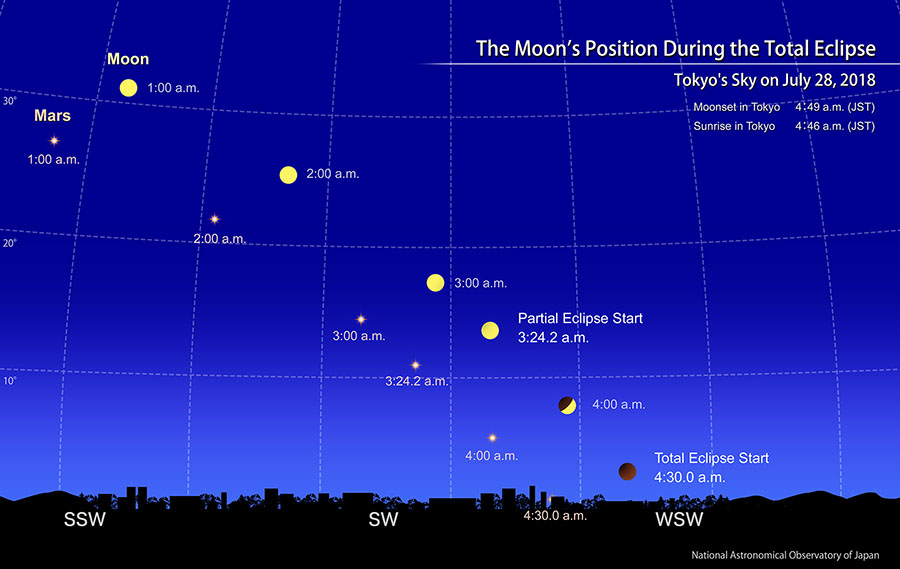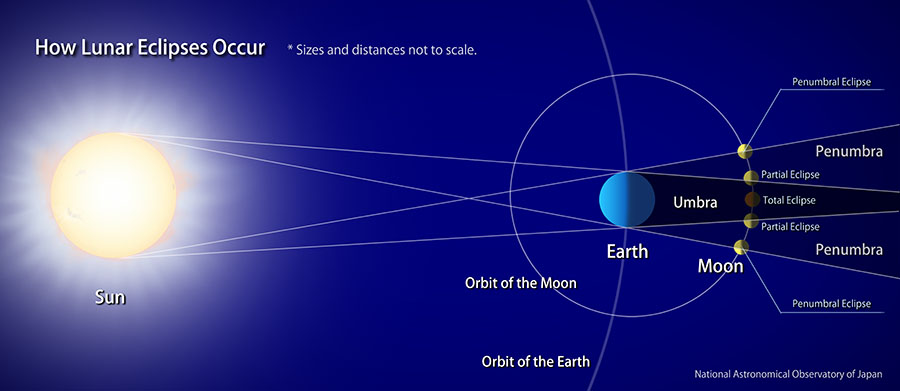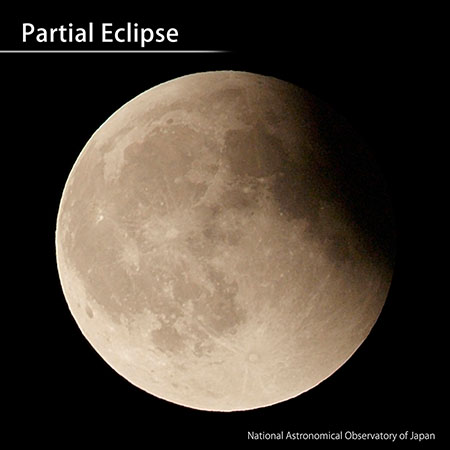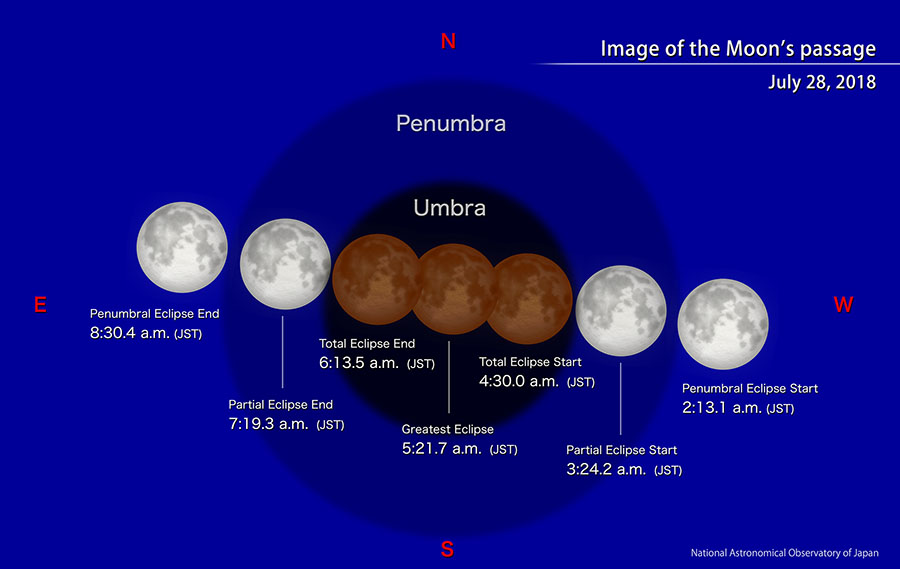Total Lunar Eclipse on July 28 (July, 2018)

Let’s Watch a Total Lunar Eclipse in the Dawn
The total lunar eclipse on July 28 will be the second total lunar eclipse of this year, following the one on January 31. From the Tohoku region and areas further west, you can see the Moon sinking low while the total eclipse is in progress. In other regions in Japan, the Moon sets before totality starts. The Moon starts to be eclipsed at 3:24 a.m. in the southwestern sky and reaches totality at 4:30 a.m. Totality will last 104 minutes (one hour and 44 minutes) until 6:14 a.m. But, the Moon sets before this time in Japan, so you cannot see the end of totality.
You can enjoy the lunar eclipse with the unaided eye. If you have a telescope or binoculars, you can also try observing the eclipse with one of those.
During totality, the Moon turns a red copper color instead of turning completely dark. In addition, celestial objects seen at low altitude are more influenced by the atmosphere than at a high altitude. At lower altitudes, objects become redder than usual. Since the altitude of the Moon is already low when the partial eclipse starts, it might look reddish before totality. Also, the sky is getting light at the time of totality, so the Moon might not be visible during totality. Let's start observing when the partial eclipse starts and enjoy the unusual Moon and landscape.
The figure above shows how the eclipse will appear as seen from Tokyo. Mars, which is about to make its closest approach to Earth, also shines brightly close to the Moon.
The detailed times of the lunar eclipse, the altitude of the Moon, and the time when the Moon sets at some locations in Japan are written below. The time when the lunar eclipse occurs does not change regardless of wherever you observe it in Japan.
| Locations in Japan | Partial eclipse starts 3:24.2 a.m. | Total eclipse starts 4:30.0 a.m. | Greatest eclipse starts 5:21.7 a.m. | Moonset time |
|---|---|---|---|---|
| Sapporo | 8.2 deg | Not Visible | Not Visible | 4:24 a.m. |
| Sendai | 11.3 deg | 1.0 deg | Not Visible | 4:38 a.m. |
| Tokyo | 13.6 deg | 2.8 deg | Not Visible | 4:49 a.m. |
| Kyoto | 16.5 deg | 5.9 deg | Not Visible | 5:7 a.m. |
| Fukuoka | 20.8 deg | 10.3 deg | 1.4 deg | 5:32 a.m. |
| Naha | 27.6 deg | 16.3 deg | 6.5 deg | 5:58 a.m. |
You can see the appearance of lunar eclipses from various places with the “Local Prediction of the Lunar Eclipse” by the Ephemeris Computation Office of NAOJ.
When is the Next One?
The last total lunar eclipse seen in Japan occurred on January 31.
The next total lunar eclipse is on May 26, 2021. That lunar eclipse can be seen from all over Japan, but in some regions, the partial lunar eclipse has already began when the Moon rises.
The next total eclipse that can be seen from the beginning to end of the eclipse from all over Japan is the one on November 8, 2022.
How Lunar Eclipses Occur
When sunlight shines on a person or object, a shadow is formed in the opposite direction from the Sun. Likewise, the sunlight makes a shadow of the Earth, which extends in the opposite direction from the Sun. A “lunar eclipse” is a phenomenon where the Moon darkens or looks like it has been chipped as it passes through the shadow of the Earth. We call it a “total lunar eclipse” when the entire Moon enters into the shadow of the Earth.
A lunar eclipse occurs only when the Sun, Earth, and Moon are aligned. This means a lunar eclipse can only occur on the full moon. However, lunar eclipses do not occur on every full moon. This is because the Moon’s orbit is inclined relative to the orbital plane of the Earth. And most times, the full moon skims past to the north or south of the Earth's shadow, without entering inside the shadow.

Please watch this video explaining about lunar eclipses.
Types of Lunar Eclipses
The Earth casts two types of shadows, penumbra (light shadow surrounding the umbra) and umbra (dark shadow where the sunlight is mostly blocked). The type of eclipse seen depends on which shadow the Moon enters.
Penumbral eclipse
A penumbral eclipse occurs when the entire Moon or part of the Moon passes through the Earth’s penumbral shadow. Because the penumbra is a dim shadow, it is quite difficult to determine if the Moon is getting darker with the naked eye. But if you look closely, you may notice that the Moon is getting slightly darker on the side closer to the umbra. When photographing with short exposures, you can clearly tell that the Moon is getting darker.
Umbral eclipse
A umbral eclipse is when the entire Moon or part of the Moon passes through the Earth’s umbral shadow. When we say “lunar eclipse,” in most cases it refers to an “umbral eclipse.” The “umbra” is a dark shadow, so the Moon clearly looks like it is chipped.

A partial lunar eclipse occurs when only part of the Moon passes through the umbra.

A total lunar eclipse occurs when the entire Moon passes through the umbra.
The Moon’s Passage

The above image shows the path of the Moon moving through the Earth’s shadow during the July 28, 2018 lunar eclipse.
Reference: Ephemeris Computation Office
With the “Sky Viewer” you can easily explore the appearance of a typical urban night sky (planets and constellations are visible). The Celestial Phenomena section of the glossary explains the planetary phenomena terms: greatest elongation, opposition, conjunction, stationary, etc.